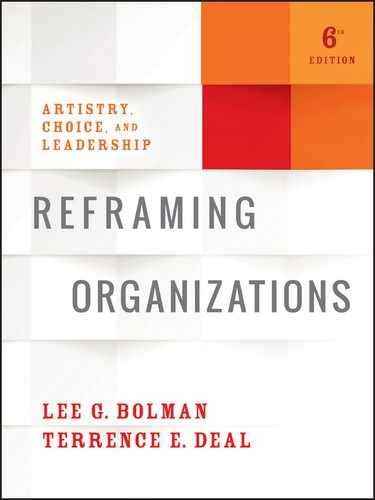Part Six
Improving Leadership Practice
A messy, turbulent world rarely presents bounded, well-defined problems, and decoding complex situations is not a single-frame activity. In this part of the book, we focus on combining lenses to achieve multiframe approaches to managing and leading.
In Chapter 15, we contrast a stereotype of crisp, orderly rationality with the more frantic, reactive reality of managerial life. We show how routine activities and processes such as strategic planning, decision making, and conflict take on different meanings depending on how they are viewed. We provide an example to illustrate the cacophony that arises when parties are seeing different realities. Finally, we look at studies of effective organizations and senior managers to examine how research aligns with our framework.
In Chapter 16, we examine a case of a middle manager who encounters an unexpected crisis on the first day in a new job. We show how each lens spawns both helpful and unproductive scenarios in a situation where the stakes and risks are high.
We turn to a discussion of leadership in Chapter 17. We begin by examining the 2016 U.S. presidential election to examine the interaction between leader and circumstances. We explore the concept of leadership and tour 100 years of leadership research. We review issues of culture and gender in leadership. Then we illustrate each frame's image of leaders and leadership.
Chapter 18 takes us to a perennial challenge: creating change. We examine predictable barriers identified in each frame and point out different remedies. We then integrate the frames with a stage model of change. The two in combination provide a powerful map.
Ethics and spirit take center stage in Chapter 19. We begin with a look at cases of dubious ethics at Siemens and Walmart. We discuss four criteria for ethical behavior: authorship, love, justice, and significance.
Chapter 20 presents an integrative case in which we zoom in on a new principal in his perilous early weeks at a troubled urban high school. We illustrate how the frames in tandem generate a more comprehensive diagnosis of the issues and offer more promising options for moving ahead.
Finally, in the Epilogue, we summarize the basic messages of the book and lay out implications for the development of future leaders.
